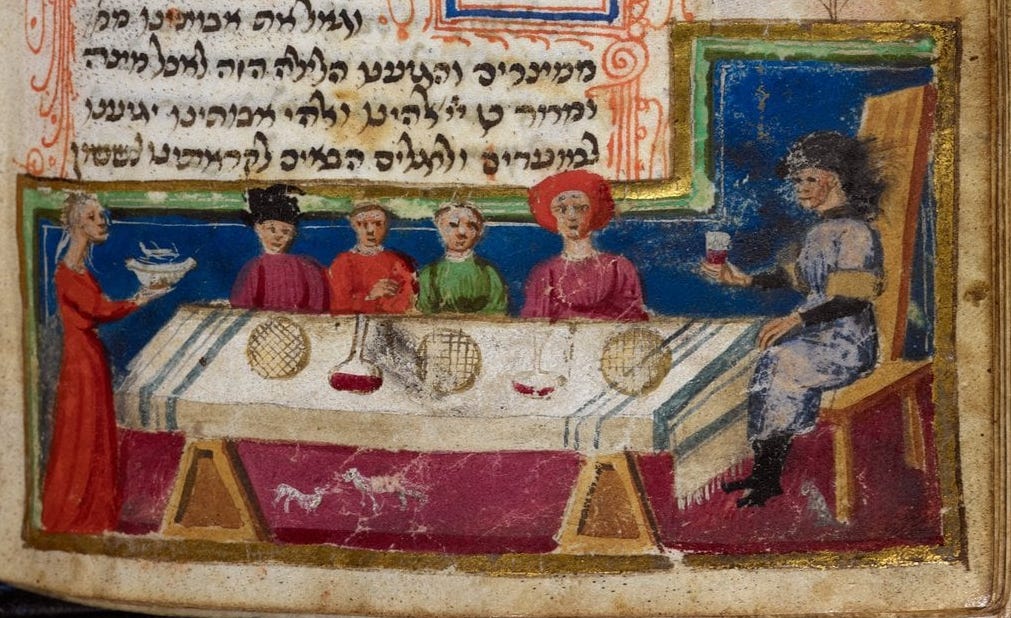As Passover begins this week, millions of Jews worldwide will turn to the Haggadah, the traditional guide to the holiday’s Seder meal. While the text is best known for recounting the biblical story of the Israelites’ escape from slavery in Egypt, historians say the Haggadah also reflects centuries of Jewish adaptation to political, cultural, and linguistic shifts in the ancient world. While its origins lie deep in Jewish tradition, the Haggadah was also molded by the Roman occupation of Judea and reflects influences from the broader Middle Eastern context in which it emerged.
A Text Born of Exile and Transformation
The roots of the Haggadah trace back nearly two millennia to a period of seismic change in Jewish life. Following the destruction of the Second Temple in Jerusalem in 70 CE by Roman forces, Jewish worship underwent a dramatic transformation. Temple-based rituals, particularly the Passover sacrifice, were no longer possible. In their place, the Seder meal evolved into a home-centered observance, and the need arose for a text to preserve and structure the Passover narrative.
What developed over the next few centuries was the Haggadah—meaning "the telling"—a compilation of prayers, biblical excerpts, rabbinic commentary, and symbolic foods, all designed to fulfill the Torah's commandment to recount the story of the Exodus. By the time of the Mishnah and later the Talmud (2nd to 5th centuries CE), the structure of the Seder and many elements of the Haggadah had taken shape.
Jewish History Under Imperial Roman Rule
During the period in which the Mishnah and the Passover rituals were being compiled (1st to 3rd centuries CE), Jewish society was shaped by a series of dramatic uprisings against Roman rule. The devastating Great Revolt (66–73 CE) ended with the destruction of the Second Temple and marked a turning point in Jewish communal and religious life. The Kitos War (115–117 CE), a lesser-known but widespread series of Jewish uprisings across Egypt, Cyprus, and Mesopotamia, followed. Finally, the Bar Kokhba Revolt (132–135 CE), led by Simon Bar Kokhba and supported by Rabbi Akiva, attempted to restore Jewish sovereignty. Though initially successful, it ended in brutal defeat, mass executions, exile, and a Roman ban on Jewish settlement in Jerusalem.
In this context of persecution and loss of political autonomy, rabbinic leaders developed a portable, text-based religious tradition that could survive without a central sanctuary. The Haggadah, like the Mishnah, became part of that enduring legacy.
One evocative passage in the Haggadah tells of rabbis gathered in Bnei Brak, discussing the Exodus story late into the night. Some scholars believe this scene may allude to clandestine resistance gatherings during Roman suppression, possibly linked to the Bar Kokhba Revolt. Regardless of the historical specifics, the story serves as a testament to Jewish perseverance under foreign rule.

Echoes of the Middle East
While Roman influence helped shape the form of the Haggadah, its content remained deeply rooted in the Jewish and Middle Eastern context of its time. The inclusion of Aramaic—a common vernacular among indigenous Middle Eastern Jews of that era—alongside Hebrew is one such example. The opening section, “Ha Lachma Anya” (“This is the bread of affliction”), is written in Aramaic. Its language reflects the lived reality of Jews in Babylonia (primarily modern-day Iraq) and Judea, where Aramaic was widely spoken.
This linguistic duality also points to the enduring influence of the Babylonian exile, which began in the 6th century BCE when much of the Jewish elite was deported to Babylon. There, Aramaic became the dominant language of Jewish life and scholarship. Even after the return to Judea, the cultural and linguistic imprints of Babylonian society persisted. The Talmud Bavli (Babylonian Talmud), one of Judaism’s central texts, emerged from this scholarly tradition—and the Haggadah draws on that same intellectual and linguistic heritage.
The Haggadah also mirrors the interpretive style of rabbinic literature, with layers of commentary, Midrashic expansion, and citations from the Hebrew Bible. These features align the text with other foundational Jewish works from the same era, including the Babylonian Talmud.
A Testament to Jewish Survival
Today’s Haggadah is more than a ritual guide—it is a chronicle of Jewish indigeneity and endurance. Across centuries of exile, persecution, and dispersion, the Jewish people have clung to the Haggadah as a symbol of survival and continuity. Whether in medieval Europe, under Islamic rule in the Middle East, or in modern diaspora communities, the story of the Exodus has offered both a spiritual anchor and a source of hope.
This Passover, as Jews gather from Tel Aviv to Toronto and beyond, they do more than recount an ancient story—they affirm a legacy of resilience. In the face of oppression, the Haggadah remains a voice of memory, identity, and unwavering spirit.



